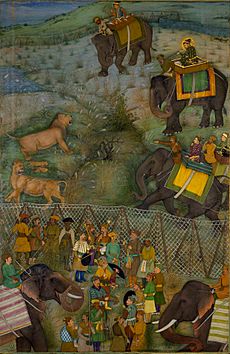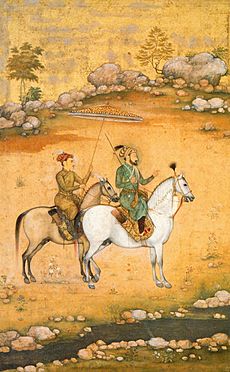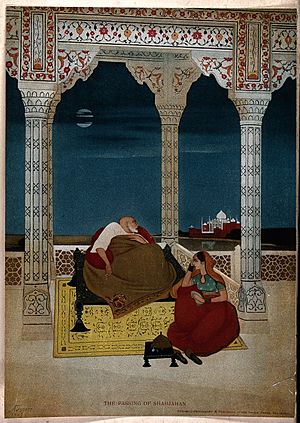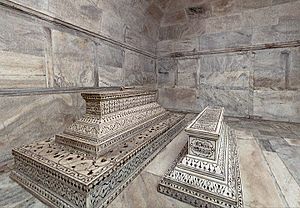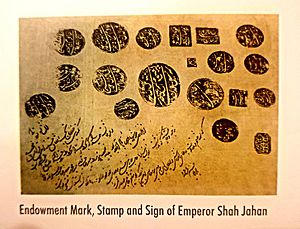Shah Jahan facts for kids
Quick facts for kids Shah Jahan I |
|||||||||||||
|---|---|---|---|---|---|---|---|---|---|---|---|---|---|
| Padishah Al-Sultan Al-Azam |
|||||||||||||

Portrait of Shah Jahan by Bichitr, c. 1630
|
|||||||||||||
| 5th Mughal Emperor | |||||||||||||
| Reign | 19 January 1628 –31 July 1658 | ||||||||||||
| Coronation | 14 February 1628, Agra | ||||||||||||
| Predecessor | Shahriyar (de facto) Jahangir I |
||||||||||||
| Successor | Aurangzeb | ||||||||||||
| Born | Khurram 5 January 1592 Lahore Fort, Lahore, Mughal Empire |
||||||||||||
| Died | 22 January 1666 (aged 74) Agra Fort, Agra, Mughal Empire |
||||||||||||
| Burial | Taj Mahal, Agra | ||||||||||||
| Consort | |||||||||||||
| Wives |
|
||||||||||||
| Issue among others... |
|
||||||||||||
|
|||||||||||||
| House | House of Babur | ||||||||||||
| Dynasty | |||||||||||||
| Father | Jahangir I | ||||||||||||
| Mother | Bilqis Makani | ||||||||||||
| Religion | Sunni Islam (Hanafi) | ||||||||||||
| Royal Seal | 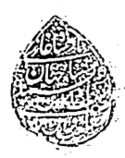 |
||||||||||||
Mirza Shihab-ud-Din Muhammad Khurram (born January 5, 1592 – died January 22, 1666), also known as Shah Jahan I, was the fifth emperor of the Mughal Empire. He ruled from January 1628 to July 1658. His name, Shah Jahan, means "King of the World." During his time, the Mughal Empire reached its highest point in architecture and culture.
Shah Jahan was the third son of Jahangir, who ruled from 1605 to 1627. Shah Jahan took part in military campaigns against the Rajputs and the Lodhis. After Jahangir died in 1627, Shah Jahan defeated his youngest brother, Shahryar Mirza. He then became emperor in the Agra Fort. Shah Jahan made sure his rivals for the throne could not challenge him. He ordered many famous buildings to be built, like the Red Fort, the Shah Jahan Mosque, and the Taj Mahal. The Taj Mahal is where his favorite wife, Mumtaz Mahal, is buried.
In foreign affairs, Shah Jahan led strong campaigns against the Deccan Sultanates. He also had conflicts with the Portuguese and wars with the Safavids. He stopped several local rebellions and dealt with a terrible famine in the Deccan region from 1630 to 1632.
In September 1657, Shah Jahan became ill. He chose his oldest son, Dara Shikoh, to be his successor. This led to a power struggle among his three sons. Shah Jahan's third son, Aurangzeb, won this struggle and became the sixth emperor. Aurangzeb removed all his surviving brothers, including Dara Shikoh. After Shah Jahan recovered in July 1658, Aurangzeb kept his father imprisoned in the Agra Fort. Shah Jahan remained there until his death in January 1666. He was buried next to his wife in the Taj Mahal. His rule is known for changing the more open policies started by Akbar. During Shah Jahan's time, Islamic revival movements began to influence Mughal policies.
Contents
Early Life and Family
Birth and Childhood
Shah Jahan was born on January 5, 1592, in Lahore, which is now in Pakistan. He was the ninth child and third son of Prince Salim, who later became Emperor Jahangir. His mother was Jagat Gosain. His grandfather, Emperor Akbar, chose the name Khurram for him. Khurram means "joyous." Akbar was very fond of young Khurram and treated him like his own son.
When Khurram was born, Akbar wanted him to be raised in his own home, not Salim's. So, Khurram was cared for by Ruqaiya Sultan Begum. She raised him with great love. Jahangir wrote that Ruqaiya loved Khurram "a thousand times more than if he had been her own son."
After Akbar died in 1605, Khurram returned to his mother, Jagat Gosain. He loved her very much. When she died in 1619, he was heartbroken and mourned for 21 days. During this time, he did not attend public meetings and ate only simple vegetarian meals. His wife, Mumtaz Mahal, made sure food was given to the poor and tried to comfort him.
Education and Early Experiences
As a child, Khurram received a good education, as was expected for a Mughal prince. He learned about military training and many cultural arts, like poetry and music. His father, Jahangir, encouraged these studies. Khurram was also interested in Hindi literature.
In 1605, when Akbar was dying, 13-year-old Khurram stayed by his grandfather's side. He refused to leave until the older women of the household, like Salima Sultan Begum and Mariam-uz-Zamani, told him to go. This was a dangerous time politically, but Khurram was protected.
Early Political Life
In 1605, Khurram's father, Jahangir, became emperor after stopping a rebellion by Prince Khusrau. Khurram stayed away from court politics at first. As the third son, he did not challenge his father or his half-brother. This allowed him to build his own support at the Mughal court.
Jahangir trusted Khurram to guard the palace and treasury. Khurram also helped his father by sharing information about plots against him. Jahangir showed his favor by weighing Khurram against gold and other riches.
Influence of Nur Jahan
Over time, Khurram became closer to his father and was seen as the likely heir. In 1608, Jahangir gave Khurram the region of Hissar-Feroza, which was usually given to the heir.
In 1611, Jahangir married Nur Jahan. She became very powerful in the court and influenced many decisions. Her relatives gained important positions. Khurram often disagreed with his stepmother, Nur Jahan. She preferred her son-in-law, Shahryar Mirza, to become the next emperor. She tried to weaken Khurram's position by sending him on distant military campaigns.
Feeling his position was in danger, Khurram challenged his father in 1622. He was not successful and lost his father's favor. After Jahangir's death in 1627, a struggle for the throne began between Khurram and his half-brother, Shahryar Mirza. Khurram won and became the fifth Mughal Emperor. Nur Jahan lost her power and lived quietly until her death. Khurram removed his main rivals to ensure his rule was unchallenged.
Marriages and Family Life
In 1607, Khurram became engaged to Arjumand Banu Begum (1593–1631), known as Mumtaz Mahal. Her name means "the chosen one of the Palace." They were engaged for five years, which was a long time back then. She came from an important Persian noble family. Her grandfather, Mirza Ghiyas Beg, was Jahangir's finance minister. Her father, Asaf Khan IV, became Chief Minister. Her aunt, Mehr-un-Nissa, became Empress Nur Jahan.
Shah Jahan first married Princess Kandahari Begum in 1610. She was the daughter of a great-grandson of Shah Ismail I of Persia. They had a daughter, his first child.
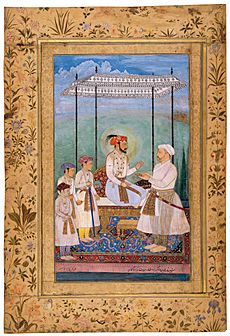
In 1612, at age 20, Khurram married Mumtaz Mahal. Their marriage was very happy, and he was devoted to her. She gave birth to fourteen children, and seven of them lived to adulthood.
Mumtaz Mahal was a smart woman and a key advisor to her husband. As empress, she had great power. Shah Jahan often asked for her advice on state matters. She was also in charge of the imperial seal, which meant she reviewed official documents.
Mumtaz Mahal died at age 38 on June 7, 1631, while giving birth to Gauhar Ara Begum. She died in Burhanpur after a long and difficult labor. Historians say Shah Jahan was "paralyzed by grief" and cried often. Her death deeply affected him and inspired him to build the Taj Mahal. Her body was later buried there.
Khurram had other wives, like Kandahari Begum and Izz un-Nisa Begum. These marriages were mainly for political reasons, and these wives did not have the same status as Mumtaz Mahal. He also married his cousin, Lilavati Bai, during a time when he was challenging his father.
Early Military Campaigns
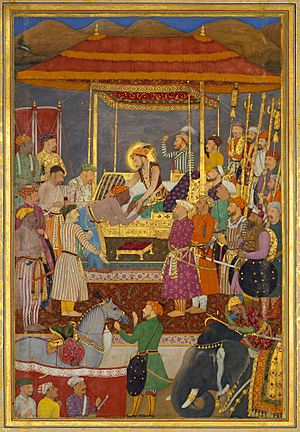
Prince Khurram showed great skill in military matters. His first chance to prove himself was during the Mughal campaign against the Rajput state of Mewar. Mewar had been against the Mughals since Akbar's rule. In December 1613, Prince Khurram was sent to Mewar.
After a year of hard fighting, Rana Amar Singh I surrendered to the Mughal forces. Mewar became a state under the Mughal Empire. In 1615, Khurram presented Amar Singh's heir, Kunwar Karan Singh, to Jahangir. Khurram was honored by Jahangir and his military rank was increased.
In 1616, Jahangir gave Khurram the title Shah Sultan Khurram when he left for the Deccan. In 1617, Khurram was sent to deal with the Lodhis in the Deccan. His goal was to secure the Empire's southern borders. After his success, Jahangir gave him the title Shah Jahan (meaning "King of the World"). He also raised his military rank even higher and gave him a special throne in his court. This was a very rare honor for a prince.
Challenging His Father
In the Mughal Empire, the next ruler was not chosen automatically. Instead, sons often competed through military success and gaining power in court. This often led to rebellions and power struggles.
In 1611, Khurram's father, Jahangir, married Nur Jahan. She quickly became a powerful figure in Jahangir's court. Her brother, Asaf Khan IV, also became very influential. Khurram's marriage to Asaf Khan's daughter, Arjumand (Mumtaz Mahal), strengthened Nur Jahan and Asaf Khan's positions.
However, Nur Jahan wanted her son-in-law, Khurram's youngest brother Shahzada Shahryar, to be the next emperor. This caused much tension. Prince Khurram did not like Nur Jahan's influence over his father. He was also angry about being less favored than Shahryar.
When the Persians attacked Kandahar, Nur Jahan ordered Prince Khurram to go and fight. But he refused. He worried that if he left, Nur Jahan would turn his father against him and convince Jahangir to name Shahryar as heir. Because of Khurram's refusal, Kandahar was lost to the Persians. This fear led Prince Khurram to challenge his father instead of fighting the Persians.
In 1622, Prince Khurram gathered an army and marched against his father and Nur Jahan. He was defeated in March 1623. He then found safety in Udaipur with Maharana Karan Singh II. It is believed that the mosaic work in the Jagmandir Palace there inspired him for the Taj Mahal. In November 1623, he found refuge in Bengal Subah. He defeated the governor of Bengal and took control of Dhaka. His rebellion did not succeed, and he had to surrender. Although he was forgiven in 1626, tensions between Nur Jahan and Khurram continued.
When Jahangir died in 1627, the chief minister, Asaf Khan (who supported Khurram), quickly acted. He stopped Nur Jahan's plans to put Prince Shahryar on the throne. He also took control of Khurram's three sons, who were under Nur Jahan's care. Asaf Khan helped Khurram become emperor.
Khurram became the Mughal emperor with the long name Abu ud-Muzaffar Shihab ud-Din Mohammad Sahib ud-Quiran ud-Thani Shah Jahan Padshah Ghazi. His name, Shah Jahan, means "King of the World." His first act as ruler was to remove his main rivals and imprison his stepmother Nur Jahan. This allowed Shah Jahan to rule his empire without challenge.
Shah Jahan's Rule
Running the Empire
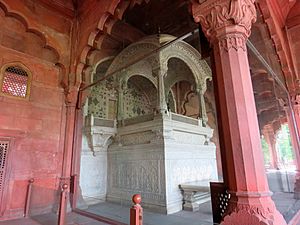
By 1648, Shah Jahan's army was very large, with over 911,400 foot soldiers and 185,000 cavalry. He also had many cannons made in the Jaigarh Fort. Under his rule, the empire became a huge military power. The number of nobles and their soldiers grew a lot, which meant more taxes were needed from the people. However, his financial and trade policies brought a time of general stability. The government became more organized, and court affairs were well-managed.
The Mughal Empire continued to grow during his reign. His sons led large armies in different areas. India was a rich center for arts, crafts, and architecture. Many of the world's best architects, artists, and writers lived in Shah Jahan's empire. During this time, India's share of the world's economy grew significantly, becoming the largest in the world by 1700.
Famine of 1630
A severe famine happened in 1630–32 in the Deccan, Gujarat, and Khandesh regions. This was because three main crops failed. Two million people died from starvation. In response, Shah Jahan set up langar (free kitchens) to help the victims.
Military Successes
In 1632, Shah Jahan captured the fortress at Daulatabad, Maharashtra. He imprisoned Husein Shah of the Nizam Shahi Kingdom. Golconda surrendered in 1635, and Bijapur in 1636. Shah Jahan made Aurangzeb the Viceroy (governor) of the Deccan region. During his time as viceroy, Aurangzeb conquered more areas.
Relations with Other Powers
Shah Jahan's forces captured Kandahar from the Safavids in 1638. But the Persians, led by their ruler Abbas II of Persia, took it back in 1649. The Mughal armies tried many times but could not get it back during the Mughal–Safavid War. Shah Jahan also expanded the Mughal Empire west beyond the Khyber Pass.
Shah Jahan sent a group of representatives to the Ottoman court in 1637. They exchanged gifts and letters, hoping for an alliance against Persia.
Shah Jahan ordered the Portuguese to be driven out of their trading post at Port Hoogly in 1631. The Portuguese were accused of illegal trading and causing problems for Mughal ports. Shah Jahan was also upset by the activities of Jesuits in the region, especially when they were accused of taking peasants. In 1632, the Mughal Army took control of the area. Shah Jahan also ordered a church in Agra to be taken down in 1635. He allowed Jesuits to practice their religion privately but banned them from converting Hindus and Muslims.
By Shah Jahan's reign, the Mughal Empire's navy was based at Kozhikode. Its job was to protect the trade routes in the Indian Ocean, which were very important for India's economy.
Revolts Against Shah Jahan
The Kolis of Gujarat often rebelled during Shah Jahan's rule. In 1622, Shah Jahan sent Raja Vikramjit to control the Kolis. Between 1632 and 1635, four different governors were appointed because they could not manage the Koli activities well.
Azam Khan was then appointed governor. He brought order to the province by controlling the Kolis. He marched against Koli rebels and made their leader, Kánji, surrender. Kánji promised not to rob again and to pay a yearly tribute. Azam Khan also built two forts in the Koli country. Later, Prince Aurangzeb was appointed viceroy in 1644. He was replaced due to religious disagreements. Finally, Prince Murad Bakhsh became viceroy in 1654. He quickly restored order and defeated the Koli rebels.
Illness and Imprisonment
In 1658, Shah Jahan became ill. His eldest son, Dara Shikoh, took over as ruler while his father was sick. This made his brothers angry. When they heard about Dara taking power, his younger brothers, Shuja and Murad Baksh, declared themselves independent. They marched towards Agra to claim their share of the wealth. Aurangzeb, the third son, gathered a strong army. He defeated Dara's army near Agra.
Even though Shah Jahan fully recovered from his illness, Aurangzeb declared him unfit to rule. He put his father under house arrest in the Agra Fort.
Jahanara Begum Sahib, Mumtaz Mahal's oldest surviving daughter, chose to stay with her father during his 8-year imprisonment. She cared for him in his old age. In January 1666, Shah Jahan became very weak. On January 30, he died at age 74.
Shah Jahan's chaplain and a Kazi (judge) came to the fort. They prepared his body and placed it in a sandalwood coffin. Princess Jahanara wanted a grand state funeral with a procession. However, Aurangzeb refused such a show. Shah Jahan's body was taken to the Taj Mahal and buried next to his beloved wife, Mumtaz Mahal.
Contributions to Architecture
Shah Jahan left behind many grand buildings. He was one of the greatest supporters of Mughal architecture. His reign is known as the golden age of Mughal architecture. His most famous building is the Taj Mahal, which he built out of love for his wife, Empress Mumtaz Mahal. Their love story has been told in many Indian artworks, books, and movies. Shah Jahan personally owned the royal treasury and many precious jewels, including the Kohinoor diamond.
The Taj Mahal was designed with great care, and architects from all over the world were invited to help. The building took twenty years to complete. It was built from white marble with a brick base. After Shah Jahan's death, his son Aurangzeb had him buried there next to Mumtaz Mahal.
Other famous buildings from his time include the Red Fort (also called the Delhi Fort or Lal Qila), large parts of the Agra Fort, the Jama Masjid, the Wazir Khan Mosque, the Moti Masjid, the Shalimar Gardens, parts of the Lahore Fort, the Mahabat Khan Mosque in Peshawar, and the Shahjahan Mosque. He also had the famous Peacock Throne, Takht e Taus, made to celebrate his rule. Shah Jahan also had beautiful verses from the Quran placed on his architectural masterpieces.
The Shah Jahan Mosque in Thatta, Pakistan, was built in 1647. It is made of red bricks with blue glazed tiles. This mosque has 93 domes, making it the world's largest mosque with so many domes. It was designed so that a person speaking at one end of the dome can be heard at the other end. It has been on the UNESCO World Heritage list since 1993.
-
The elegant Naulakha Pavilion at the Lahore Fort was built during the reign of Shah Jahan.
-
Shah Jahan and the Mughal Army return after attending a gathering in the Jama Masjid, Delhi.
-
Finial, Tamga of the Mughal Empire (combining a crescent and a spear pendant with the word Allah).
Coins of Shah Jahan
Shah Jahan continued to make coins from three metals: gold (mohur), silver (rupee), and copper (dam). Coins made before he became emperor have the name Khurram.
-
Silver rupee coin of Shah Jahan, from Patna.
| Styles of Shah Jahan |
|
|---|---|
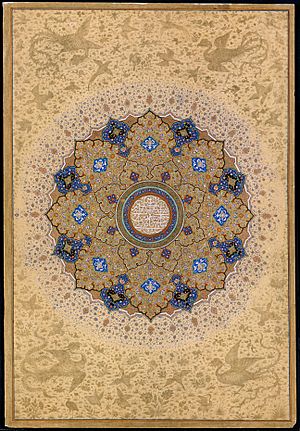 |
|
| Reference style | Shahanshah |
| Spoken style | His Imperial Majesty |
| Alternative style | Alam Pana |
Children of Shah Jahan
| Name | Portrait | Lifespan | Notes |
|---|---|---|---|
| Parhez Banu Begum | 21 August 1611 - 1675 |
Shah Jahan's first child born to his first wife, Kandahari Begum. Parhez Banu was her mother's only child and died unmarried. | |
| Hur-ul-Nisa Begum | 30 March 1613 - 5 June 1616 |
The first of fourteen children born to Shah Jahan's second wife, Mumtaz Mahal. She died of smallpox at the age of 3. | |
| Jahanara Begum Padshah Begum |
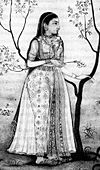 |
23 March 1614 - 16 September 1681 |
Shah Jahan's favorite and most influential daughter. Jahanara became the First Lady (Padshah Begum) of the Mughal Empire after her mother's death. She died unmarried. |
| Dara Shikoh Padshahzada-i-Buzurg Martaba, Jalal ul-Kadir, Sultan Muhammad Dara Shikoh, Shah-i-Buland Iqbal |
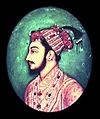 |
20 March 1615 - 30 August 1659 |
The eldest son and heir-apparent. His father, Shah Jahan, favored him as a successor. He was defeated and later died during the power struggle with his younger brother, Prince Muhiuddin (later Emperor Aurangzeb). He married and had children. |
| Shah Shuja | 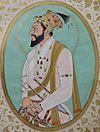 |
23 June 1616 - 7 February 1661 |
He survived the initial power struggle. He married and had children. |
| Roshanara Begum Padshah Begum |
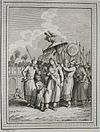 |
3 September 1617 - 11 September 1671 |
She was an influential daughter of Shah Jahan and supported Aurangzeb during the power struggle. She died unmarried. |
| Aurangzeb Mughal emperor |
 |
3 November 1618 - 3 March 1707 |
Became the sixth Mughal emperor after winning the power struggle that followed Shah Jahan's illness in 1657. |
| Jahan Afroz | 25 June 1619 - March 1621 |
The only child of Shah Jahan's third wife, Izz-un-Nissa (titled Akbarabadi Mahal). Jahan Afroz died at the age of one year and nine months. | |
| Izad Bakhsh | 18 December 1619 - February/March 1621 |
Died in infancy. | |
| Surayya Banu Begum | 10 June 1621 - 28 April 1628 |
Died of smallpox at the age of 7. | |
| Unnamed son | 1622 | Died soon after birth. | |
| Murad Bakhsh |  |
8 October 1624 - 14 December 1661 |
He died in 1661 during the power struggle. He married and had children. |
| Lutf Allah | 4 November 1626 - 13 May 1628 |
Died at the age of one and a half years. | |
| Daulat Afza | 8 May 1628 - 13 May 1629 |
Died in infancy. | |
| Husnara Begum | 23 April 1629 - 1630 |
Died in infancy. | |
| Gauhara Begum | 17 June 1631 - 1706 |
Mumtaz Mahal died while giving birth to her on 17 June 1631 in Burhanpur. She died unmarried. | |
| Purhanara Begum | died After 1666 | ? | |
| Nazarara Begum | ? | ? |
See also
 In Spanish: Sha Jahan para niños
In Spanish: Sha Jahan para niños
- Shah Jahan II
- Shah Jahan III
- Wine cup of Shah Jahan
- Shahjehan, 1946 Indian film about the emperor






